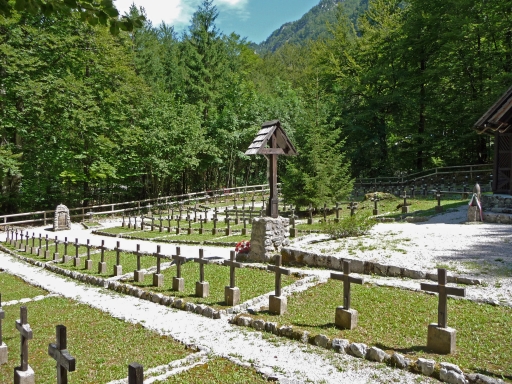The Central Powers launched an offensive against Italy on 24 October 1917, achieving a significant breakthrough after more than two years of fighting on the Isonzo river.
German troops joined Austria-Hungary for the attack, exploiting weaknesses in the Italian positions to outflank them in a battle that was to be named after Caporetto, a town in the Isonzo valley (present-day Kobarid in Slovenia).
Within two weeks, the Italian army was forced back some 130 kilometres (80 miles) towards the heartlands of the Veneto region.
But the Central Powers’ spectacular advance lost momentum because of lengthening supply lines, and it was finally checked at another river, the Piave, in early November.
Hundreds of thousands of Italian soldiers were either taken prisoner or deserted. More than two million civilians found themselves under occupation. As well as military defeat, the Italian authorities had to cope with a refugee crisis.
Cadorna dismissed
The disaster cost General Luigi Cadorna his job as Italian army chief. Cardorna, who had a reputation for harsh discipline, was replaced by General Armando Diaz.
Erwin Rommel, the future Second World War commander, was among young German officers who learned from his experiences at Caporetto.
Ernest Hemingway, a volunteer ambulance driver, set his novel, A Farewell to Arms, against the background of the Italian campaign.
Fearing an Italian collapse, Britain and France sent troops to buttress the country’s war effort.
A conference of Allied leaders – held in the riviera town of Rapallo in November 1917 – also agreed to set up a permanent Supreme War Council, including the United States, to improve coordination.
In June 1918, the forces of Austria-Hungary attempted another attack on the Piave. Four months later, the Habsburg empire suffered defeat and its final collapse at the Battle of Vittorio Veneto.
Caporetto in context
Autumn 1917 was a season of mixed fortunes in the First World War. On all sides, except America which had yet to enter the conflict in earnest, there was growing war-weariness.
*On October 23, the French captured Fort Malmaison on the Chemin des Dames, helping to revive morale after the disasters of the Nivelle offensive in the spring. The Germans fell back to a new defensive line.
*In the Middle East, Australian, British and New Zealand troops took Beersheba from the Ottomans on October 31, paving the way for an advance into Palestine.
*The Bolshevik revolution on November 7 finally ended Russia’s flagging participation in the Great War as an ally of Britain and France.
*And on November 10, Canadian troops took Passchendaele. But the Allied advance, originally conceived as a breakout from the Ypres salient, amounted to only eight kilometres (five miles) since July 31.
Also in Centenary News:
WW1 Italian photos discovered in Australia.
Images courtesy of Hugh Pearman
